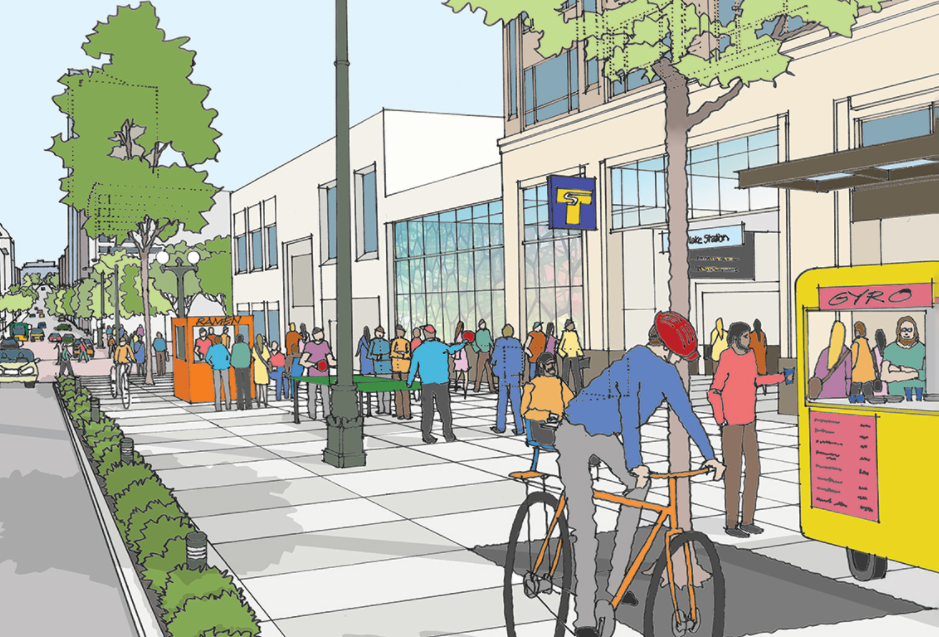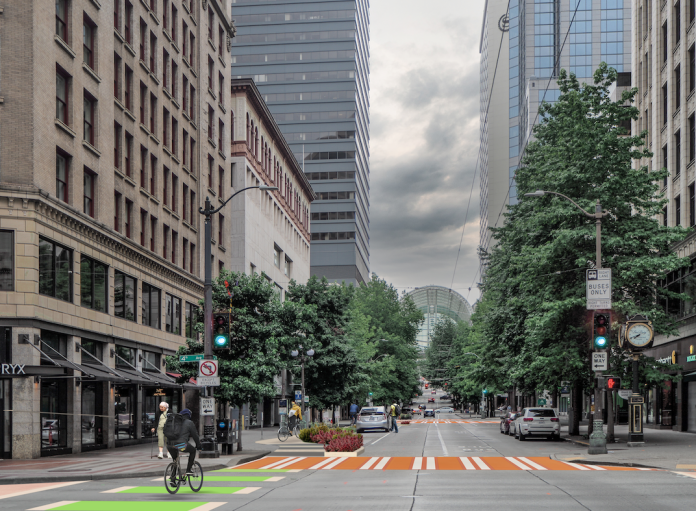
The planned overhaul of the Pike Pine corridor in downtown Seattle will undoubtedly become one of the most significant changes to Seattle’s retail core since perhaps the opening of Westlake mall and park in the late 1980s. The approximately $40 million revamp, dubbed the Pike Pine Renaissance, will finally complete the protected bike lanes on the corridor connecting to and from Capitol Hill, and upgrade them to have sturdy barricades for their entire length. Both Pike and Pine Streets will be extended as one-way streets all the way up to Bellevue Avenue on Capitol Hill. Pedestrian space, particularly around Pike Place Market, will also see an expansion. The road to completing this project has been long, with the first concepts seen nearly four years ago.
The Urbanist has obtained the latest set of designs, dated this summer at the 60% level of design completion, including updated renderings and a full map of the corridor. Several problematic steps backward shown in the latest update, combined with aspects that have been less-than-ideal all along, show a project straying from achieving its full vision, a dismaying fact given the project’s price tag and intended impact.
One of the biggest changes since the last set of designs was released last year: wider sidewalks and concrete bike lane barriers have been removed from the project on the Pike Street bridge over I-5. The city’s transportation department Media and Public Affairs Lead Ethan Bergerson told us that the reason for the change is the added weight.
“Analysis of the bridge load ratings of both bridges has shown that the Pike Street bridge is not capable of accepting the added weight of a concrete sidewalk expansion and concrete bike lane buffer, while the Pine Street bridge is capable of accepting both of these elements,” Bergerson told us. “It should be noted that the 2019 update to [the Washington State Department of Transportation’s] Bridge Design Manual updated the load rating criteria for box girder bridges. The updated criteria required a different (more restrictive) load rating criteria be used for box girder bridges with bottom slab widths greater than 60 feet. At 30% design, initial indications were that improvements could be made on the Pike Street bridge and then the update to the Design Manual changed that.”
The latest plans for that stretch of Pike Street show just a paint buffer, likely with plastic posts.
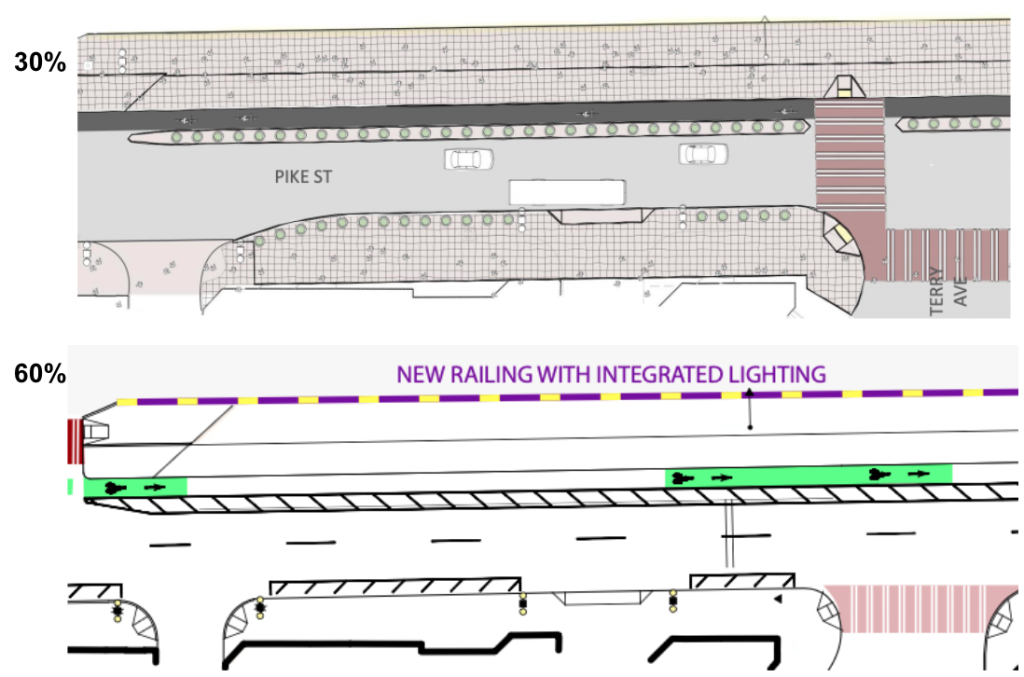
Obviously, this is a significant change from what was proposed in earlier iterations of the project, and a big step back. The improvements to the bridges over I-5 are a pivotal part of the project, and the Washington State Convention Center expansion is providing a large amount of money as a public benefit to be invested in improving unpleasant pinch points like this one. The final material isn’t completely determined yet, according to Bergerson: “The project team is committed to improving both pedestrian and bicycle facilities on the bridge and continues to explore ideas to accomplish this goal while respecting the weight limitations of the bridge structure.” But without being able to expand the sidewalk, it doesn’t look like the changes to the Pike Street overpass will accomplish the goals that were set out to be achieved with this project.
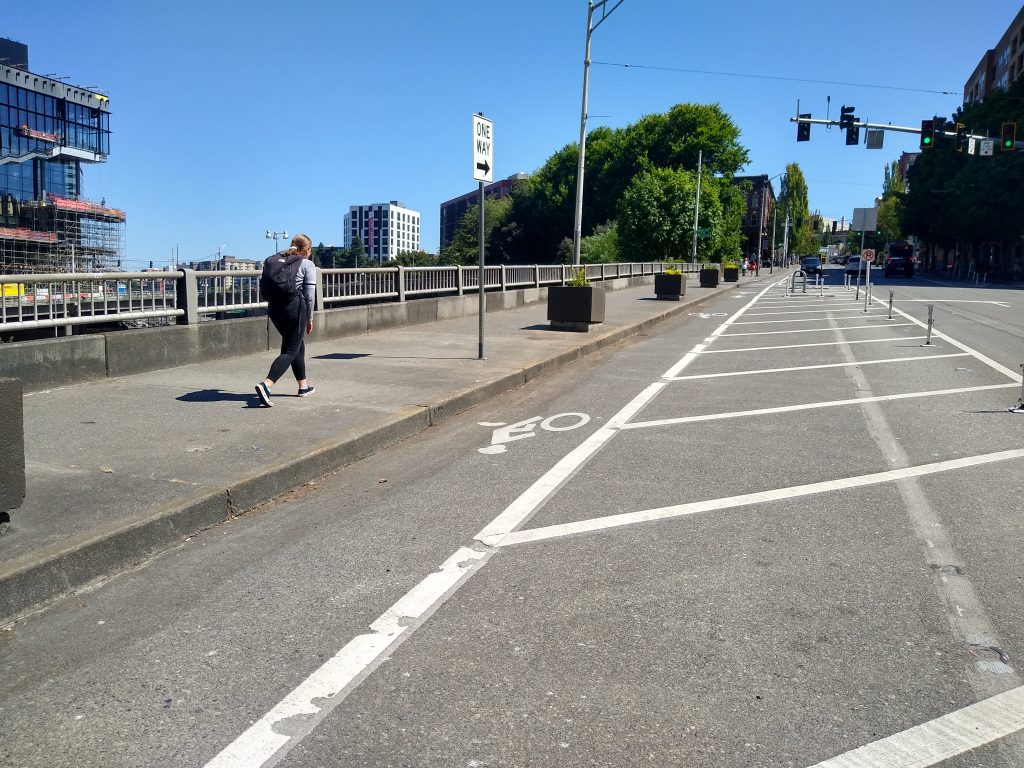
The new renderings do confirm that the expanded sidewalk and concrete barriers remain on the Pine Street counterpart over I-5. These renderings show the new railings being installed along the freeway as part of the project.
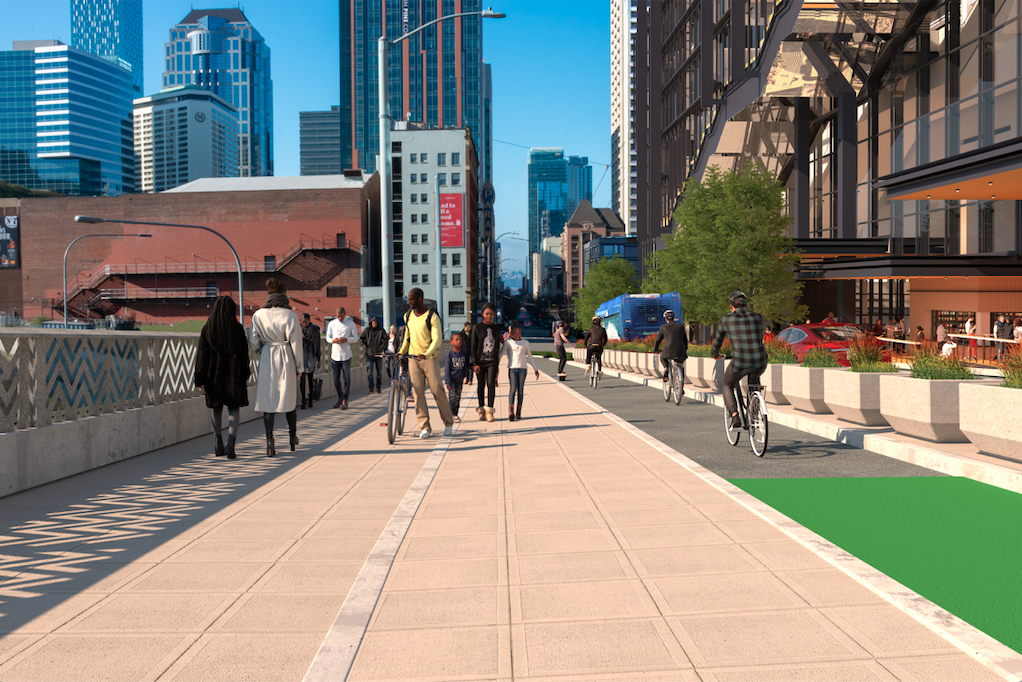
Another change is the planned transition between Capitol Hill’s protected bike lanes on Pike Street, where both directions run along the same street, and the one-way couplets downtown. Last year’s designs showed a two-way bike lane planned for the block of Pike Street between Melrose and Bellevue Avenues, where riders heading up the hill would use a bike box to cross the street at Bellevue Ave and riders heading down the hill would turn onto Melrose Avenue to connect to Pine Street. The new plan is much less complicated: the one-way bike lanes on either side of Pike Street will stay in place between Melrose and Bellevue and eastbound riders will cross the street at Melrose. This change will benefit eastbound buses who have to turn left at Bellevue and seems like a much better option than the previous iteration. Of course, the transition between Pike and Pine on Melrose would be better if the entire street was pedestrianized.
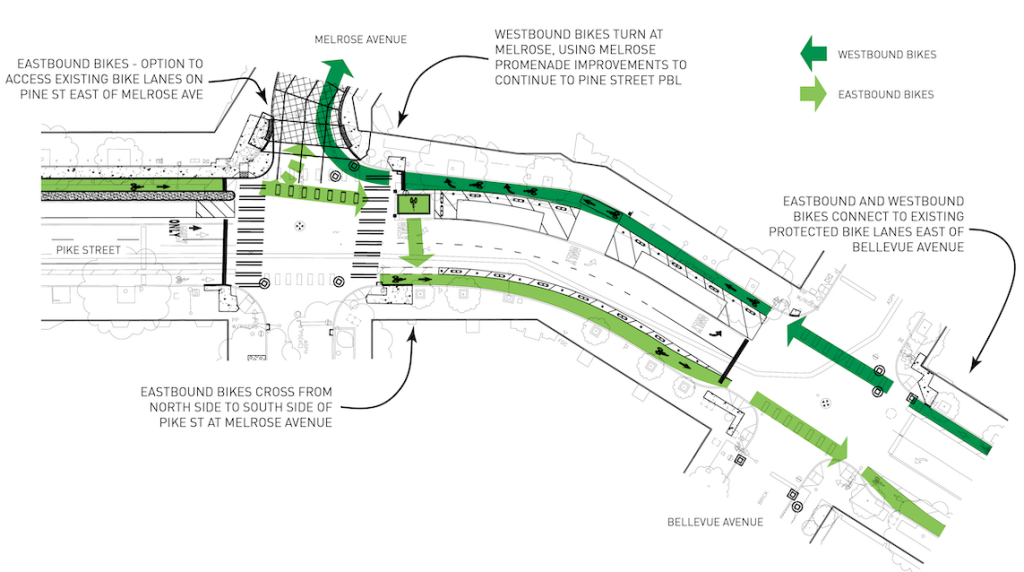
The expectations for the activated street space at Pine Street and 3rd Avenue also got lowered a bit with the new plans. Since the launch of the Pike Pine Renaissance project, concepts for this block have shown expanded sidewalk space occupied by vendors outside the entrance to Westlake Station, the state’s busiest light rail station. Sound Transit recently decided that the best use for King County Metro’s now-defunct bus pass sales kiosk was as a security desk, but vendors outside the station on space that used to be back-angle parking might be even better. Those vendors made it through 2020’s update but are now absent, likely a victim of red tape.

But perhaps, the most disappointing part of the project remains the blocks of Pike and Pine Streets between 1st and 2nd Avenues. These streets are still envisioned as curbless “shared” streets, but thanks to the current interpretation of the fire code, the area for vehicles will remain incredibly wide, with a twelve-foot vehicle lane in the center, surrounded on both sides by a small gutter that you’ll probably want to avoid if you’re on a bike, but which probably will not deter vehicles from being parked in the clear space on either side.
The renderings depict someone riding a bike between the gutter and the tree well on one side, presumably to ride against the direction of traffic, but the sidewalk will be a much safer option for someone doing that. Wider sidewalks will be nice here, but this is just a missed opportunity in every way for the type of pedestrian street Seattle needs more of. We’re told shared streets are all the rage in Europe, but this isn’t how to do it.
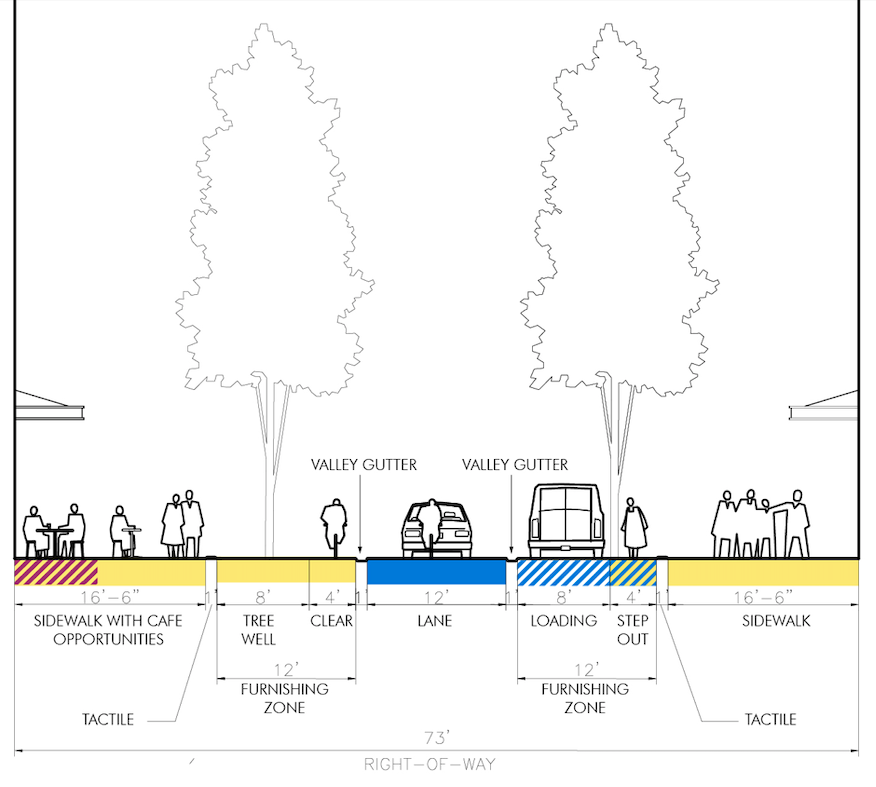
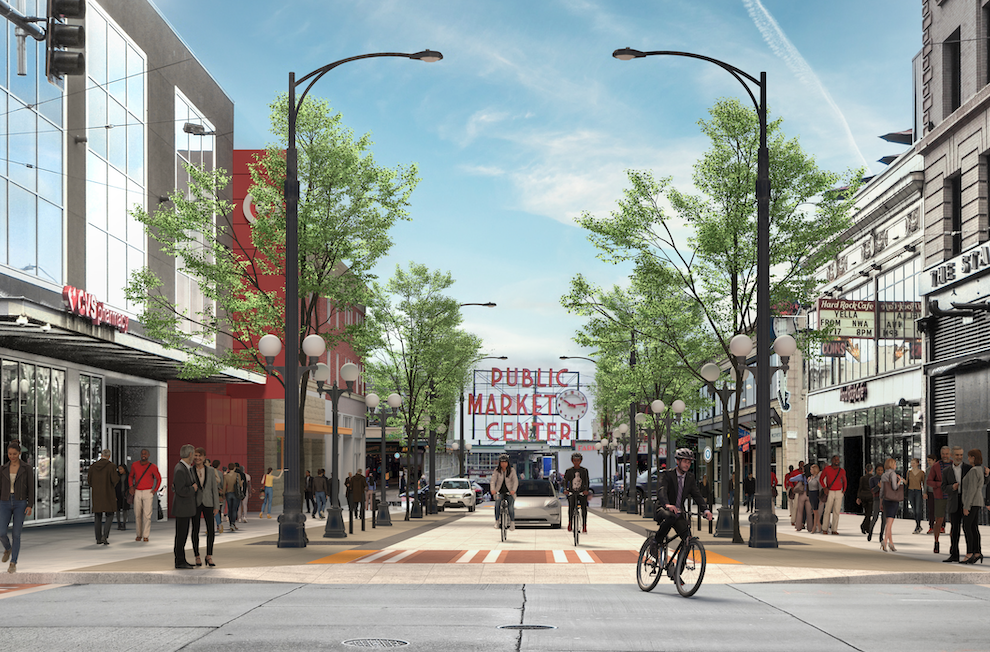
The Pike Pine Renaissance project is slated to start construction in fall of 2022, after these plans are completely finalized. With completion, a desperately needed fully-separated bike connection between downtown and Capitol Hill will finally be realized. But I can’t help but think that such a major investment in our city’s retail core should be bringing more transformative change, allowing the area to shift away from some of the car-centric decisions that have guided it in the past. When the ribbon is cut on this project, we’re going to lament the fact that it fell short of that vision.
Ryan Packer has been writing for The Urbanist since 2015, and currently reports full-time as Contributing Editor. Their beats are transportation, land use, public space, traffic safety, and obscure community meetings. Packer has also reported for other regional outlets including BikePortland, Seattle Met, and PubliCola. They live in the Capitol Hill neighborhood of Seattle.

